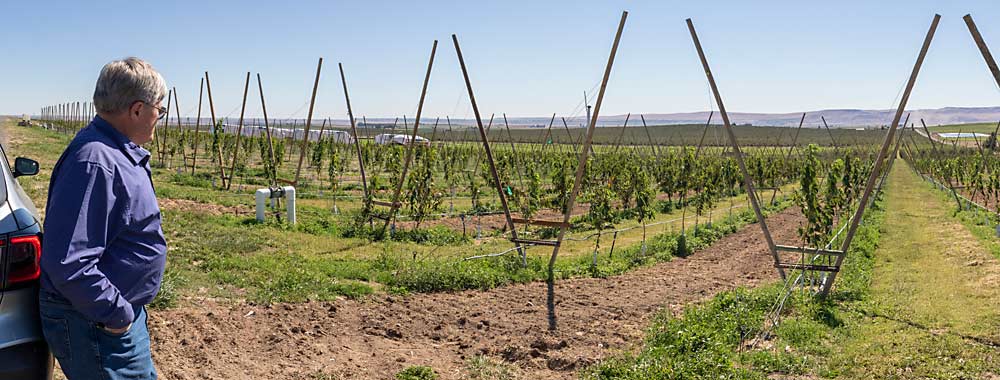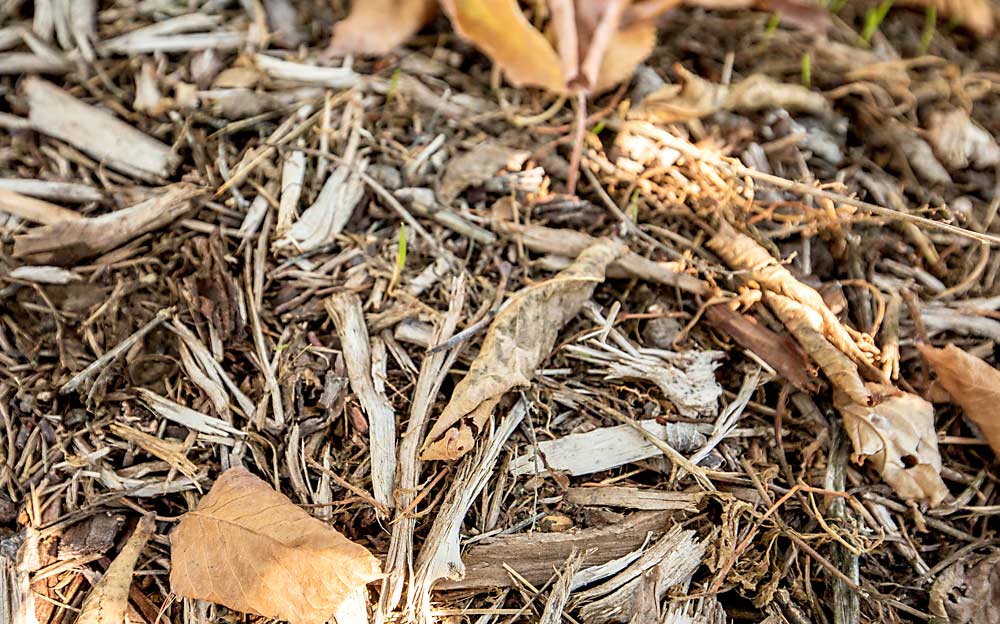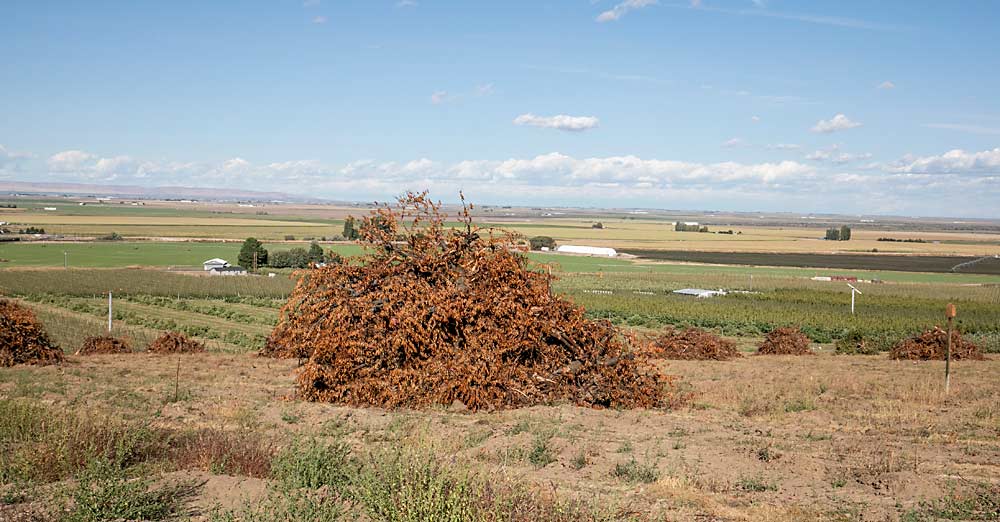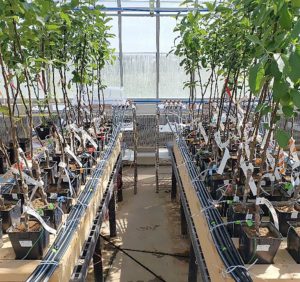
What’s the carbon footprint of a Washington apple? When orchardists plant trees, do they sequester enough carbon to cancel out the impacts of the farm’s fertilizer and fuel inputs?
Today’s retailers are starting to ask those questions, but the tree fruit industry doesn’t have the answers — yet.
“Carbon neutrality and carbon sequestration are big buzzwords right now … and other industries are leaps and bounds in front of us on this carbon sequestration road,” said Washington grower Mike Robinson.
He compares the new climate-impact focus on food production to that of the recent food safety focus: Retail customers want this new information, and growers will have to figure out how to provide it, whether they like it or not. But, he suspects it will be “more pleasant” than adapting to food safety regulations.
“At the end of the day in the business we are in, especially if we fix a couple of glitches, we will come out as carbon negative and as good citizens from a climate perspective,” he said.
To get from here to there, however, requires new data on apple production. To start filling the gaps, the Northwest Horticultural Council’s science advisory committee has been working with climate experts who are designing a life-cycle assessment of Washington’s apples.
That’s exactly what it sounds like: an accounting of all the climate implications of apple production, from the steel trellis to the impact of different nutrient management practices, said David Epstein, NHC’s vice president for scientific affairs. Some information is already available; some will need to be researched or estimated.
“The bottom line is that everyone in the world wants climate-smart agriculture, and no one knows what that really means,” he said. “A lot of what is coming from the government right now is targeting the big row crops that make up the bulk of the land mass, and it’s all about crop rotation, till or no till, and it doesn’t really pertain to us. We need baseline data specific to Pacific Northwest apple production.”
The goal is an industry-informed plan that life-cycle assessment expert Greg Thoma of Colorado State University and Washington State University researchers can submit to the Washington Tree Fruit Research Commission early next year for funding.
The end goal: a tool growers can use to see how their farms fare and how changes in practice could alter the carbon equation, said Brent Milne, horticulturist for McDougall and Sons and chair of NHC’s climate change subcommittee.
“We want to be able to tell our own story, and I think it’s a positive story,” he said. “But we’ve got to have a baseline to understand what we are doing through an entire season, from the standpoint of greenhouse gas emissions, and hopefully we can show positives from carbon sequestration.”

Incentives need information
Such tools already exist, but they were designed for commodity crops.
The U.S. Department of Agriculture is using the COMET-Farm accounting system, while many in Europe use the Cool Farm Tool.
The COMET tool allows users to enter data for permanent crops such as almonds, grapes and cherries, but it’s trying to put those crops into the commodity crop framework. No apple tool is currently available, after users reported a glitch.
“We’ve honestly got a huge knowledge gap in orchard systems or any perennial fruit systems,” said Chad Kruger, director of the Center for Sustaining Agriculture and Natural Resources at Washington State University. “The challenge with modeling an orchard is it’s two crops in the same space, the trees and the cover crop, and most tools that anybody can pick up and play with are too simplified to do orchard systems in a meaningful way.”
The initial focus on commodity crops made sense, Kruger said, as a small change in the carbon footprint per acre across millions of acres can add up to a significant impact for the climate and for growers who could reap carbon credits for the changes in practice.
For intensively managed tree fruit systems — high dollars on small acres — the value of such carbon credit would likely be “budget dust,” he said.
But incentives may be a different story.
The only questionable practice among tree fruit growers is burning trees at the end of the life cycle, Robinson said. If armed with data to show that a transition from burning to chipping would be a climate win, the industry might be able to make the case for funding to support growers’ changes in practice.
Kruger agreed. After 25 years, an orchard has accumulated a lot of carbon. “This is where some creative thinking that’s incentivized by carbon policy could make a big difference,” he said.
The USDA recently announced $2.8 billion for 70 pilot projects aiming to reduce the climate impact of different commodities. Tree fruit crops were notably absent, because the industry lacks the data to show what management changes would be worth incentivizing, said Kruger, who was part of previous life-cycle assessments for grains and potatoes.
In grain systems, on the other hand, having that data led to the University of Idaho landing $55 million to provide assistance to the state’s grain, bean and potato producers to adapt climate-smart practices.
Under Washington state’s new Climate Commitment Act, agriculture is largely exempt from regulations at present but may be eligible for incentives with the revenue raised. But again, tree fruit is largely absent — unless they make the case that orchards could be eligible for the credits designed for forest land, though Kruger and others think this will be so small on a per-acre basis that it’s not viable for growers to pursue.
“My gut instinct is there will never be an incentive big enough for tree fruit growers to care, except that their retailers want to know,” Kruger said.

Retailers now, regulators later?
If retailers care, so must producers.
At some point, someone will require growers to assess climate impacts in some specific way, Milne said. “We have a chance here to define it for ourselves first.”
Kruger describes the life-cycle assessment, or LCA, as a first step, using the information already available in growers’ balance sheets, such as fertilizer inputs or fuel usage, and identifying other research needs to provide industry-wide answers.
What’s missing currently: the net-negative side of the equation showing how apple trees and orchard soils sequester carbon.
“We don’t have the metrics to say, for example, these perennial crops in the ground over the years offset the diesel costs. That’s what the LCA should help us do,” said Tim Pitz, a horticulturist for Mount Adams Orchards and a member of NHC’s climate change subcommittee.
It will also identify potential climate-friendly changes in practice.
“As (Colorado’s) Thoma says, the goal is to find the hot spots where, with a little bit of work, you can make the most difference in greenhouse gas emissions, carbon emissions and sequestration or nitrification,” Epstein said. “But if you aren’t using your own data, you are really shooting blind.”
At the same time, a new long-term research effort being launched by the USDA’s Appalachian Tree Fruit Research Laboratory will capture the detailed carbon balance of an orchard through its 25-year productive life. (See “Carbon accounting.”)
“Somebody needed to do that and take that long path,” Kruger said. Annual cropping systems have already used these kinds of studies to refine their models. Over time, tree fruit will be able to do the same thing. And while the work will be based in West Virginia, it will be linked to data collection in Washington and elsewhere, to translate the findings to different climates, he added.
Answering the question of apple production’s climate impacts will take time, Epstein said, but it’s worth doing.
“Everyone is being impacted by drought and fires from our changing climate,” he said. “If we are going to do all this effort to understand how our industry can help, why not do it right?”
by Kate Prengaman







Leave A Comment